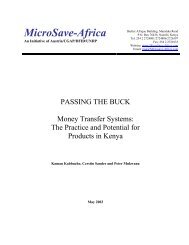Create successful ePaper yourself
Turn your PDF publications into a flip-book with our unique Google optimized e-Paper software.
<strong>DAI</strong>’s first, large foray<br />
into microenterprise<br />
paid <strong>of</strong>f with the<br />
GEMINI project.<br />
Through its many<br />
publications, GEMINI<br />
energized the<br />
intellectual debate<br />
over microenterprise<br />
development.<br />
48<br />
a grueling proposal process and stiff competition,<br />
<strong>DAI</strong> was awarded the GEMINI contract in<br />
the final days <strong>of</strong> September 1989, the end <strong>of</strong> the<br />
U.S. government’s fiscal year. It was an auspicious<br />
victory. The contract was administered in<br />
Washington but allowed USAID missions across<br />
the globe to “buy in,” adding country program<br />
funds to access the expertise <strong>of</strong> <strong>DAI</strong> and its<br />
subcontractors. The face value <strong>of</strong> the five-year<br />
core contract was $5.7 million; however, the<br />
cumulative buy-in activities over that period<br />
amounted to much more. As the implementer <strong>of</strong><br />
GEMINI, <strong>DAI</strong> was—in Boomgard’s words—“the<br />
center <strong>of</strong> the universe,” and top microenterprise<br />
talent worldwide was soon knocking at <strong>DAI</strong>’s<br />
door.<br />
By the end <strong>of</strong> 1989, with strong support and<br />
guidance from Elisabeth Rhyne, who directed<br />
GEMINI for USAID, Boomgard had an out-<br />
Photo by Jorge Vinueza<br />
standing core team in place: Maria Otero from<br />
ACCION, Nan Borton from <strong>DAI</strong>, and, later, Matt<br />
Gamser, who joined from ITDG in the United<br />
Kingdom. Some <strong>of</strong> GEMINI’s earliest endeavors<br />
were applied research studies exploring the<br />
links between microenterprise and gender, poverty<br />
lending, and the growth and dynamics <strong>of</strong><br />
intermediary institutions. The GEMINI team was<br />
soon producing high-quality technical reports<br />
at a steady clip. By 1991, field activities were<br />
under way in half a dozen countries. The work<br />
was varied, but it usually involved appraising<br />
local industries, identifying obstacles to and opportunities<br />
for growth, and providing technical<br />
assistance to government agencies and local<br />
institutions that supported microenterprise development.<br />
GEMINI drove the message, which<br />
became gospel, that micr<strong>of</strong>inance was banking<br />
and that, to succeed, micr<strong>of</strong>inance institutions<br />
needed to behave like banks.<br />
The launch <strong>of</strong> GEMINI field activities coincided<br />
with the appearance <strong>of</strong> new development<br />
opportunities unprecedented in <strong>DAI</strong>’s history—<br />
rapid changes were sweeping through Central<br />
Europe, and the Soviet Union had begun falling<br />
apart. In 1990, USAID decided to place a<br />
long-term policy advisor in Poland, where the<br />
Solidarity movement had paved the way for<br />
a democratic transition and the new government<br />
was starting to put open-market policies<br />
in place. In 1992 came a call for small business<br />
advisory services in Mongolia and a handful <strong>of</strong><br />
tasks involving field assessments in Kazakhstan,<br />
Ukraine, and Uzbekistan, all former Soviet



